When to start garden seeds indoors: Seed starting calculator
8.2 years ago cheap, indoor growbox, indoor seed starting, seedling, seeds

When you start seeds indoors in a vegetable garden, it can be difficult getting your schedule down to ensure that start your vegetable seeds with enough lead time that they are mature enough to venture outside but also not so large they take over your growing area.
Personally this has been a difficult part for me where I am really good getting the early vegetables started on time (onions, peppers, tomatoes) but when it comes to the later plants and/or second/third plantings is where I begin to get forgetful. Over the years I have come across a couple of great tools to make this easier that I thought I would share.
No matter which option you choose to start garden seeds indoors you will need to determine an important date, your last frost date. There are many sites/tables out there that will give an estimate I actually have a couple posts on the subject but at the moment my favorite site that makes this very easy is WeatherSpark, it uses historical data with great visuals to easily determine when the best probability of picking the right date. Here you can take a look at this historical data and make your call of what date you think will be safe.
1. Create a garden schedule. Just by figuring out your last frost date and doing a little math (Excel works great for this) you can determine the optimal seed starting dates and even get a general idea of when your plants should be ready for transplanting. What I love about this technique is you can tweak it each year as things worked well (or not so well) in previous years to get the schedule finely tuned to your particular garden and the micro-climates within it.
In addition knowing an estimate of when these plants will be venturing out in the wild can assist in your space planning for your seeding area as well as having a reality check if you see your peppers will be ready to be transplanted in March when it doesn’t get above freezing until mid-June.
Here is my schedule for starting seeds indoors my area and estimated last frost date (April 20th), though sure everyone that is reading this will not have the same date as mine so thanks to my infinite nerdiness I made the following table so you can adjust the “Last Frost Date” to yours and see how my schedule would look in your area.
| Last Frost Date: |
| Vegetable Name | Seed Start Date | Estimated Transplant Date |
Estimated Harvest Date |
| Celery | 1/19/2013 | 3/18/2013 | 4/24/2013 |
| Onion | 1/19/2013 | 3/25/2013 | 5/24/2013 |
| Leeks | 1/19/2013 | 3/21/2013 | 6/3/2013 |
| Kale | 1/26/2013 | 3/7/2013 | 3/22/2013 |
| Artichoke | 1/31/2013 | 4/27/2013 | 6/20/2013 |
| Kohlrabi | 2/9/2013 | 3/15/2013 | 4/5/2013 |
| Pak Choi | 2/9/2013 | 3/6/2013 | 4/10/2013 |
| Parsley | 2/8/2013 | 4/6/2013 | 4/24/2013 |
| Lettuce | 2/9/2013 | 3/6/2013 | 4/5/2013 |
| Broccoli | 2/9/2013 | 3/15/2013 | 4/20/2013 |
| Pepper – Jalapeno | 2/9/2013 | 4/28/2013 | 4/25/2013 |
| Pepper – Bell | 2/9/2013 | 5/4/2013 | 4/25/2013 |
| Swiss Chard | 2/16/2013 | 3/20/2013 | 4/7/2013 |
| Cabbage | 2/16/2013 | 3/31/2013 | 5/7/2013 |
| Brussel Sprouts | 2/22/2013 | 3/31/2013 | 5/23/2013 |
| Collards | 3/2/2013 | 3/24/2013 | 5/1/2013 |
| Tomato | 3/2/2013 | 5/4/2013 | 5/21/2013 |
| Spinach | 3/9/2013 | 4/23/2013 | |
| Peas | 3/9/2013 | 5/13/2013 | |
| Turnips | 3/9/2013 | 5/8/2013 | |
| Watermelon | 3/16/2013 | 5/27/2013 | 6/14/2013 |
| Basil | 3/24/2013 | 5/14/2013 | 6/22/2013 |
| Potatoes | 3/30/2013 | 7/8/2013 | |
| Radish | 3/31/2013 | 5/5/2013 | |
| Beets | 3/31/2013 | 6/4/2013 | |
| Carrots | 4/9/2013 | 6/23/2013 | |
| Corn | 4/9/2013 | 5/7/2013 | 6/28/2013 |
| Cucumber | 4/9/2013 | 5/16/2013 | 6/8/2013 |
| Okra | 4/9/2013 | 5/11/2013 | 6/13/2013 |
| Pumpkin | 4/9/2013 | 5/7/2013 | 7/28/2013 |
| Summer Squash – Sunburst | 4/9/2013 | 5/16/2013 | 6/3/2013 |
| Winter Squash – Hunter | 4/9/2013 | 5/16/2013 | 7/3/2013 |
| Zucchini | 4/9/2013 | 5/16/2013 | 6/3/2013 |
| Lettuce | 4/13/2013 | 6/7/2013 | |
| Beans | 5/4/2013 | 7/13/2013 | |
| Dill | 5/11/2013 | 7/15/2013 | |
| Carrots | 5/27/2013 | 8/10/2013 | |
| Broccoli | 6/22/2013 | 8/2/2013 | 8/31/2013 |
| Cabbage | 6/22/2013 | 8/2/2013 | 9/10/2013 |
| Kale | 6/22/2013 | 7/22/2013 | 8/16/2013 |
| Kohlrabi | 6/22/2013 | 7/29/2013 | 8/16/2013 |
| Cabbage – Napa | 7/24/2013 | 8/21/2013 | 10/7/2013 |
| Pak Choi | 7/24/2013 | 8/21/2013 | 9/22/2013 |
| Onion – Bunching | 7/24/2013 | 10/2/2013 | |
| Turnip | 7/24/2013 | 9/22/2013 | |
| Lettuce | 8/3/2013 | 9/27/2013 | |
| Spinach | 8/10/2013 | 9/24/2013 | |
| Corn Salad | 8/10/2013 | 9/29/2013 | |
| Garlic | 10/12/2013 | 2/14/2014 | |
| Pak Choi | 12/14/2013 | 1/26/2014 | 2/12/2014 |
* N/A because vegetables should be sown directly in the ground.
2. Create a garden plan online and get reminders. My favorite online vegetable gardening software is GrowVeg. It is very easy to use and provides some great visuals when to specifically plant seeds and transplant your seedlings outdoors, which you can see below.
In addition you also can recreate a virtual copy of your garden and plan exactly where you want to plant your vegetables, to ensure your ambitions for growing a huge crop this year does not exceed the reality of the limited space you have to actually grow. It also remembers where you planted vegetables in previous years to help enforce crop rotation to ensure pests/diseases will be forced to remain in check.
Though one of my favorite features is the weekly reminders, once a week you get a simple email letting you know what plants you should be starting/transplanting that week. This was very helpful later in the season where I probably would have completely forgotten about my carrots without this helpful reminder.
3. Buy a garden planning book. If you want something that you can really get your hands on you might want to check out the Week-by-Week Vegetable Gardener’s Handbook helps with this problem by providing weekly reminders of what vegetables you should be order/planting and what preparations you should be doing in your garden. This can be a very helpful tool in getting a little more organized in your vegetable garden.
Already falling behind on your seed planting here are a few great options to get a great selection of seeds without spending a lot of money:
- One of my favorites is Burpee Seeds, they have been around since 1876 and definitely know their stuff. The actually have a seed sale going on now where you get $15 off on order of $75 (just use code AFFB4A35) expires on 1/15
.
- The name is not too exciting but Generic Seeds
offers no thrills packaging with quality seeds and very reasonable prices and if you spend $20 or more shipping is on them.
New way to use egg cartons for starting seeds
10.2 years ago cheap, indoor seed starting, planter, seedling
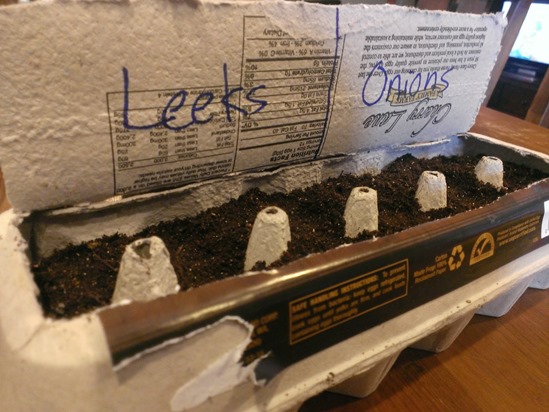
I have used egg cartons to plant seedlings before but here is a slight twist, instead of taking the whole lid off I cut the top off the lid. This not only gives you a neat place to label your seeds but more importantly, it provides an extra inch of depth for your seedlings to get a running start before being transplanted to your garden.
Multiple rain barrels hooked up with common garden hose connectors
10.2 years ago cheap, DIY, rain barrels
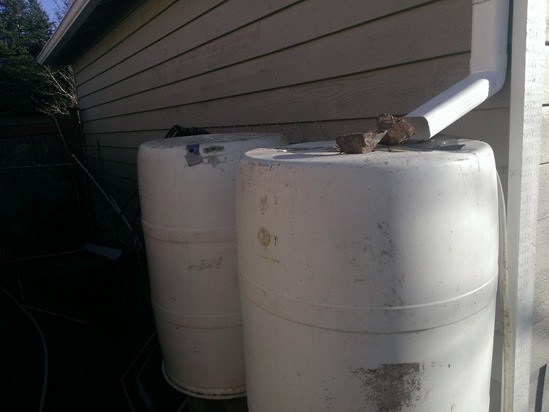
Last summer I setup some cheap rain barrels which I describe in this post which worked great though had one major flaw. If you wanted to do some maintenance or add any new barrels you would have to literally have to saw them apart. This time around I came up with a design that is not only simple but can be done with almost no tools and uses common garden hose connectors.
Materials needed
- 55 gallon food grade plastic barrels X 2
- 2 way garden hose splitter (plastic will work but recommend metal for longer life)
- Old garden hose
- Male garden hose mender
- Teflon plumbers tape
- Cinder Blocks (at least 2 for each water barrel…I went with 6 for each barrel for additional water pressure)
- 4”X4” Lumber (8 foot)
- Screwdriver
- Utility knife
Construction
Knowing Pascal’s principle I wanted to take advantage of all the height I could safely get. I chose to elevate my rain barrels by taking cinder blocks 2 wide and 3 high. I then place two 4”X4” lumber cut at 4 foot lengths to provide a few additional inches of height, but also provide some room for my connections under the barrels.
Now I have a firm foundation not it is time to get these barrels hooked together so I can get maximum water pressure and access to the water in all of the barrels.
The caps on the barrels (pretty common) I picked up had a nice feature of including some nice threads on the inside of them. This provides me a nice 1 inch thread I can get a nice tight seal. The only problem these are sealed closed.
Not having a drill bit just under one inch in diameter I used a pocket knife to carefully cut the inner cap off being careful to not harm the threads.
Whats also great about this threads is they match that of standard garden hose connections. So my taking the male end of one of the garden hose splitter with a 4-5 wrappings in Teflon plumbers tape and screw it into the cap you opened up in the previous step. Repeat this process for all of your remaining rain barrels.
Note: This addition of Teflon plumbers tape is technically optional should be water tight without this but seems like a cheap insurance for the alternative of having a slow leak under your barrels.
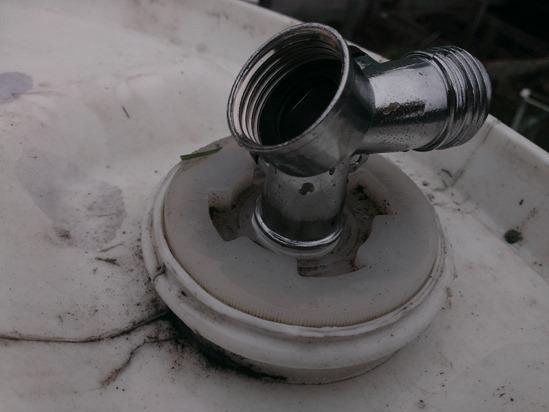
Next add one end of male the garden hose to the end you typically would hook up to your faucet and hook the other end (other male end created using Male garden hose mender mentioned above. For this I cut an old garden hose which had a couple leaks in it to proper length since obviously 25 feet of hose between barrels would be some serious overkill.
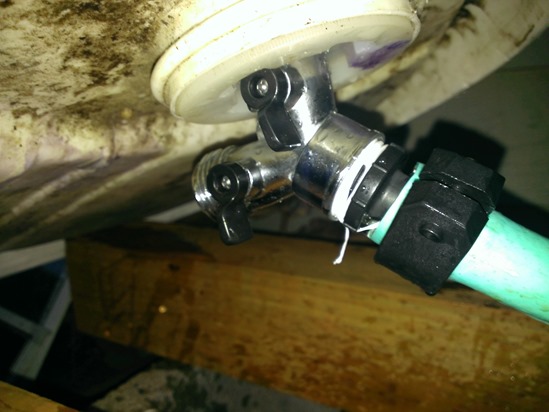
If you have more than two rain barrels you can then use short lengths of typical garden hose (one male/one female) and link them together in a similar manner.
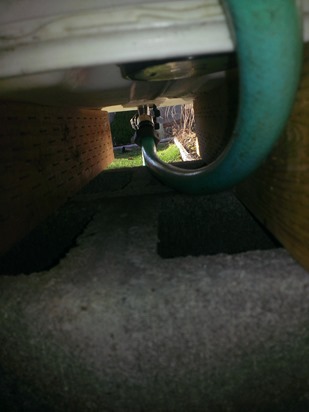
For overflow I went with a pretty simple option of drilling a hole and manually threading a pipe fitting that attached to piece of tubing (easy finds at your local home improvement store)
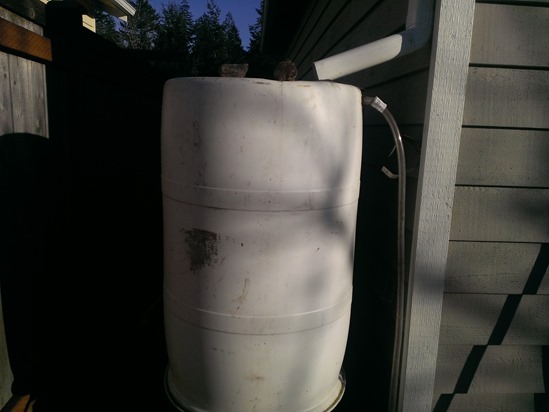
Better picture of overflow…this tube goes right down to the drain the water used to flow down with the drain spout. So once all the barrels are full all the excess water will just flow down here.
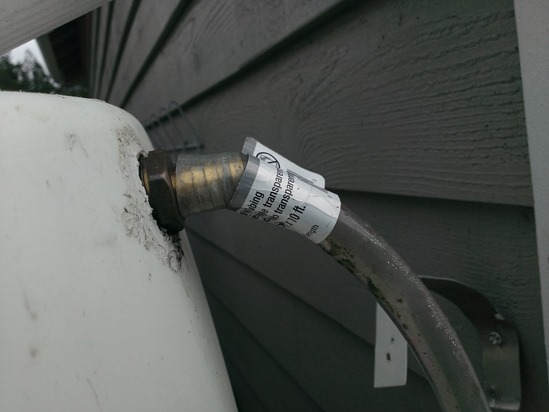
Speaking of the drain spout I used some cheap vinyl drain pieces to redirect the water into a 3 inch hole I cut in the top of the barrels.
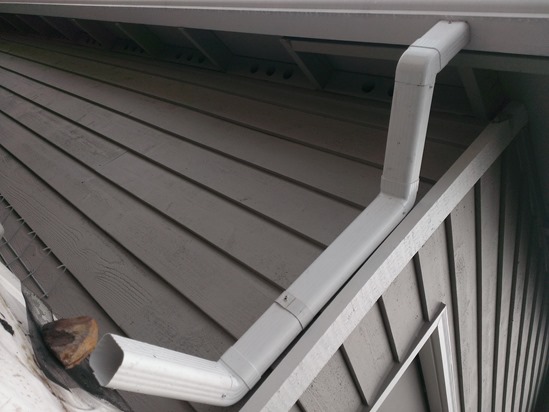
I added a piece of screen to filter out the leaves and little piece of sediment that may come from the roof. I also screwed on a plastic lid I scavenged from the recycling bin which I cut a matching 3 inch hole into. This had a decent lip on the lid to help direct the water into the barrels when the rain starts coming down pretty hard.
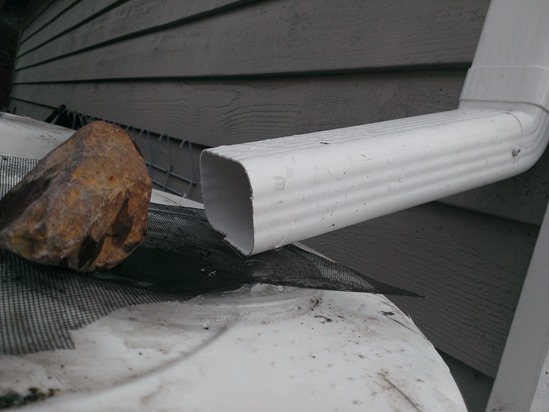
Overall I really like how this came out. Not only does this allow me to easily add new rain barrels and I decide to add them but I also with the valves on the 2 way garden hose splitter I can easily start/stop flow from any barrel and do maintenance on another barrel without having to draining all of the water from the system.
Making your own potting soil
10.3 years ago cheap, compost, fertilizer, soil sifter
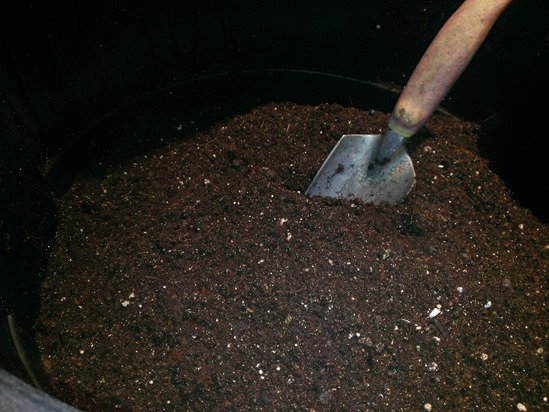
The last few years have bought a bag or two of potting soil for my spring planting though each year I am disappointed when I open the bag containing a bunch of bark , twigs, gravel, and even several pretty large rocks.
This year I have decided to make my own potting soil with very little effort and much less cost. Given I just recently harvested my compost bin and got about 15 gallons of screened compost as my starting point to make my own mix.
CVG Potting Soil Recipe
Ingredients:
- 15 gallons of screened compost
- 1 brick coconut coir (hydrated)
- 4 cups of vermiculite or perlite
- 1 cup organic fertilizer
Directions:
Add all ingredients to 20 gallon trash container. Mix thoroughly with large shovel until everything is well incorporated. Cover with lid with several holes drilled in the top (otherwise moisture+no light = mold growth)
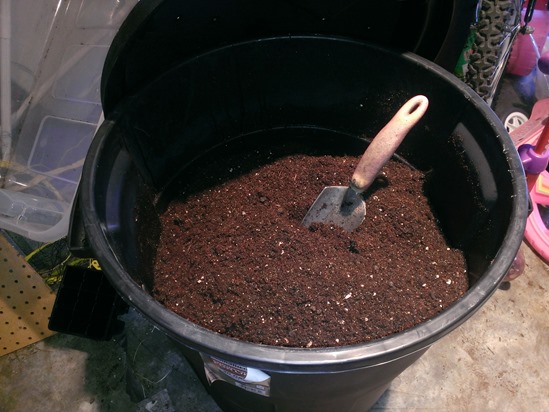
You can use a smaller container than 20 gallons but would not recommend one smaller or it can be a decent reach to get the last of the soil out of the bottom…
Add aeration to compost bin with irrigation pipes
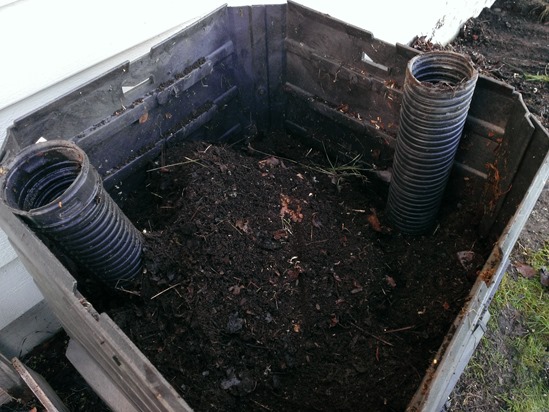
Here is a quick and easy way to add additional aeration and also provide a convenient way to deeply water your compost during dry months.
Simply cut to length of corrugated irrigation pipe with a utility knife and run them through your compost bin.
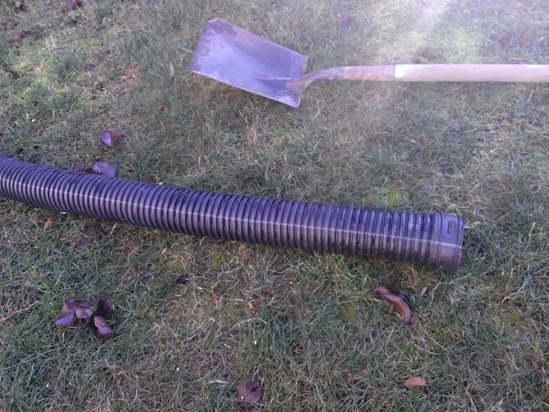
Fill with uncomposted material being careful to not add material in the exposed tube(s). This should allow better airflow to your compost bin without the extra effort of turning your material as often.
How to make a tomato/cucumber cage
10.8 years ago cheap, cucumbers, DIY, tomato, trellis
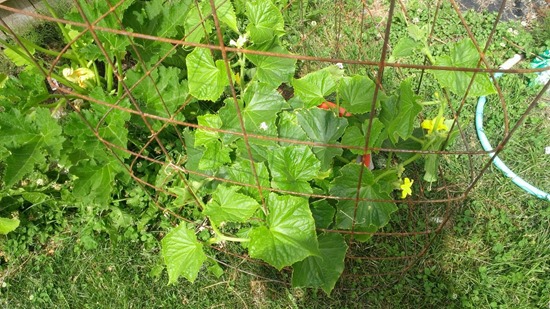
In my area, the tomatoes and cucumbers plants are starting to take off and are in desperate need of some additional support. After walking the aisles of my local home improvement store I couldn’t make myself pay the $15-30 for a single support. Sure they look real pretty but at that price it could take a few seasons to even break even for an inexpensive vegetable like cucumbers.
For this build I wanted something that was inexpensive and would be strong and hold up for years to come. My first thought was cattle panels they are made of 1/4 inch steel. You can find them even thicker if you want, but this size was perfect for my needs and is much easier to work with.
Note: For those observant people out there you may see some similarities between the cucumber/tomato cage and my pea tower…well they are the same thing and in my case I even reused my pea trellis tower to use with my cucumbers when my peas stopped producing. So this is a great multi-tasker in the garden.
Construction
First I started with a 4 foot by 8 foot cattle panel which ran me about $6 at Home Depot.

Given the panel had sharp edges and my largest vehicle is a pretty new minivan with leather seats I planned ahead and started the construction in the Home Depot parking lot (yeah got a couple funny looks) Taking a piece of scrap lumber I brought with me, I placed it on the 5th cross section on one side and bent it up until it was perpendicular to the ground then repeated with the other side.

The I carefully placed the bent panel into my minivan and brought it home for the remaining construction which pretty much was adding a zip tie in the middle to make a isosceles triangle and then tucked both ends to interweave with the other open side of the tower.
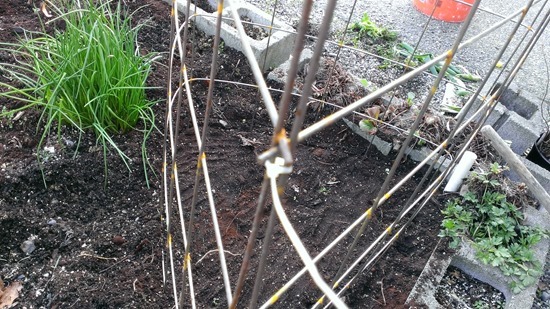
Next I used some pliers to not have as many sharp pointy parts for my kids…probably more likely me to poke myself with and also filed down any ends that seemed overly sharp. If you happen to have an angle grinder this would be a great way to quickly take care of these

Now you have everything constructed all you need to do is carefully place this over your tomato or cucumber plants and they shouldn’t have any problems climbing up this structure. I also just used my foot to push the pointy ends on the bottom into the ground to provide some additional support.
You might also see in this case I am also using a self watering 5 gallon bucket for my planter for this cucumber plant which has been working awesome. Just top off the water every few days and every two weeks include a little fish fertilizer in with the water to keep the growth vigorous.
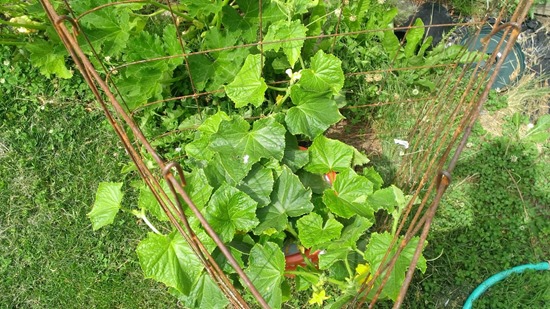
Due to the size and shape of this design it should remain very stable the entire season and many more to come and at just $5-6 a piece and about 5 minutes of work a great value as well.








